oil temperature MAZDA MODEL B3000 4WD 2002 Owners Manual
[x] Cancel search | Manufacturer: MAZDA, Model Year: 2002, Model line: MODEL B3000 4WD, Model: MAZDA MODEL B3000 4WD 2002Pages: 288, PDF Size: 1.87 MB
Page 9 of 288
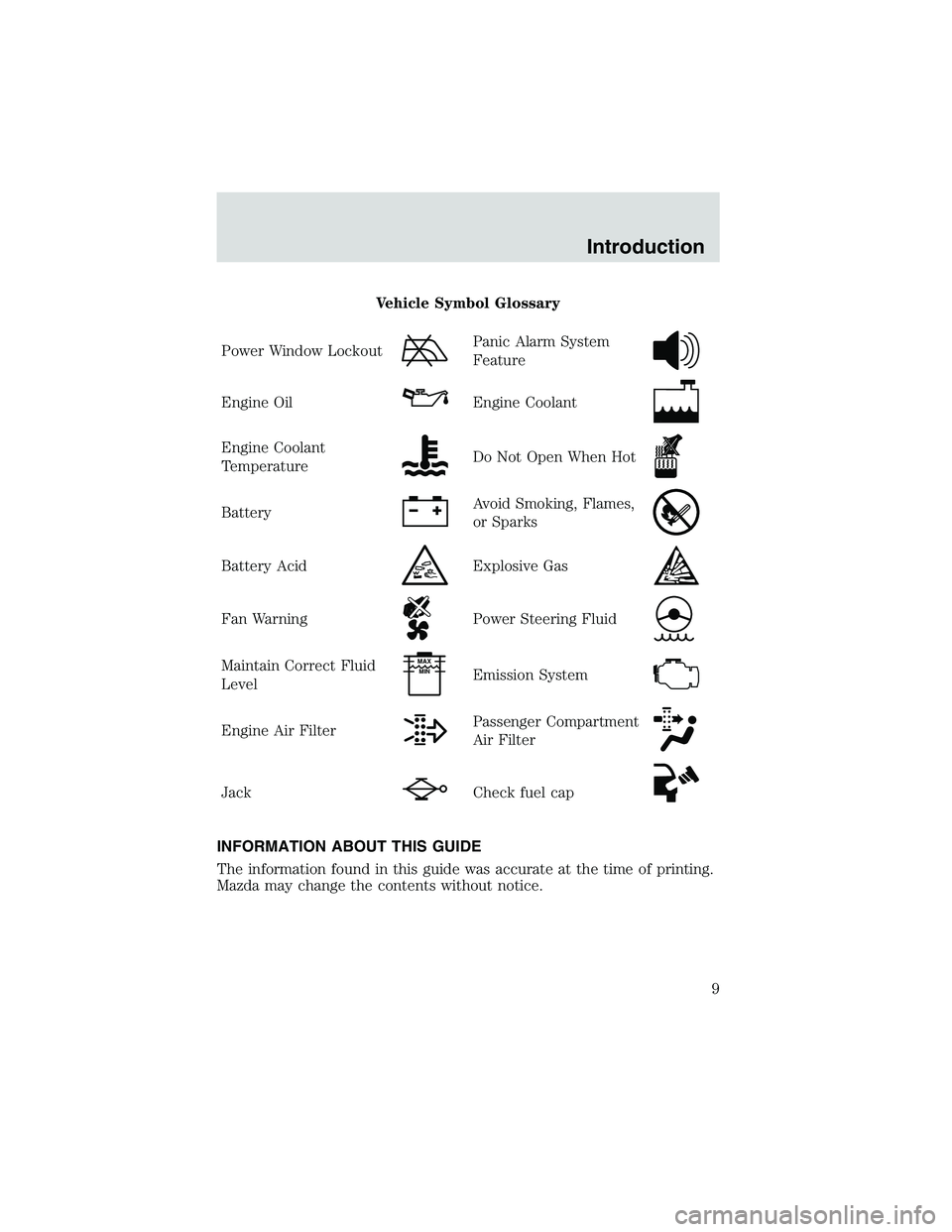
Vehicle Symbol Glossary
Power Window Lockout
Panic Alarm System
Feature
Engine OilEngine Coolant
Engine Coolant
TemperatureDo Not Open When Hot
BatteryAvoid Smoking, Flames,
or Sparks
Battery AcidExplosive Gas
Fan WarningPower Steering Fluid
Maintain Correct Fluid
LevelMAX MIN
Emission System
Engine Air FilterPassenger Compartment
Air Filter
JackCheck fuel cap
INFORMATION ABOUT THIS GUIDE
The information found in this guide was accurate at the time of printing.
Mazda may change the contents without notice.
Introduction
9
Page 13 of 288
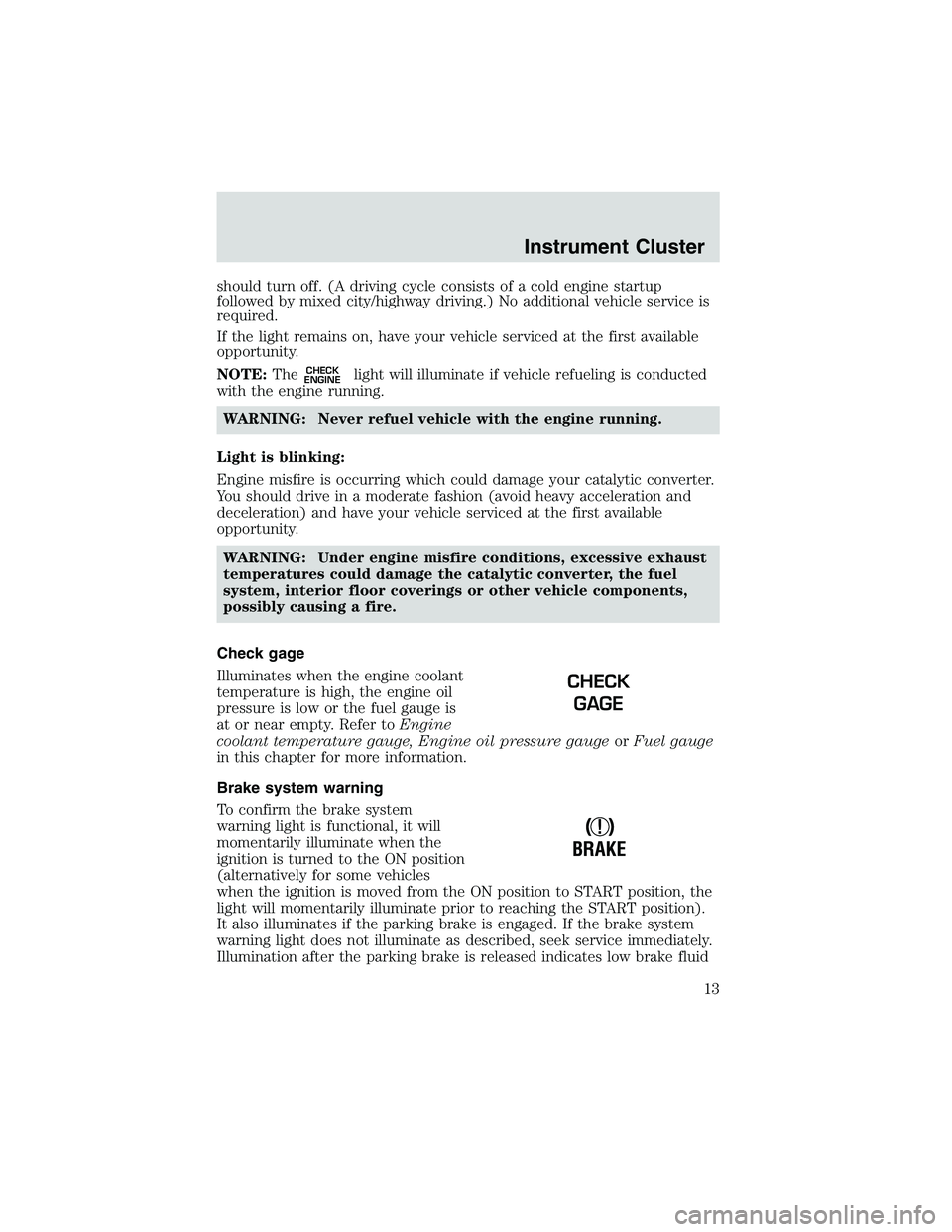
should turn off. (A driving cycle consists of a cold engine startup
followed by mixed city/highway driving.) No additional vehicle service is
required.
If the light remains on, have your vehicle serviced at the first available
opportunity.
NOTE:The
CHECK
ENGINElight will illuminate if vehicle refueling is conducted
with the engine running.
WARNING: Never refuel vehicle with the engine running.
Light is blinking:
Engine misfire is occurring which could damage your catalytic converter.
You should drive in a moderate fashion (avoid heavy acceleration and
deceleration) and have your vehicle serviced at the first available
opportunity. WARNING: Under engine misfire conditions, excessive exhaust
temperatures could damage the catalytic converter, the fuel
system, interior floor coverings or other vehicle components,
possibly causing a fire.
Check gage
Illuminates when the engine coolant
temperature is high, the engine oil
pressure is low or the fuel gauge is
at or near empty. Refer to Engine
coolant temperature gauge, Engine oil pressure gauge orFuel gauge
in this chapter for more information.
Brake system warning
To confirm the brake system
warning light is functional, it will
momentarily illuminate when the
ignition is turned to the ON position
(alternatively for some vehicles
when the ignition is moved from the ON position to START position, the
light will momentarily illuminate prior to reaching the START position).
It also illuminates if the parking brake is engaged. If the brake system
warning light does not illuminate as described, seek service immediately.
Illumination after the parking brake is released indicates low brake fluid
CHECK
GAGE
!
BRAKE
Instrument Cluster
13
Page 19 of 288
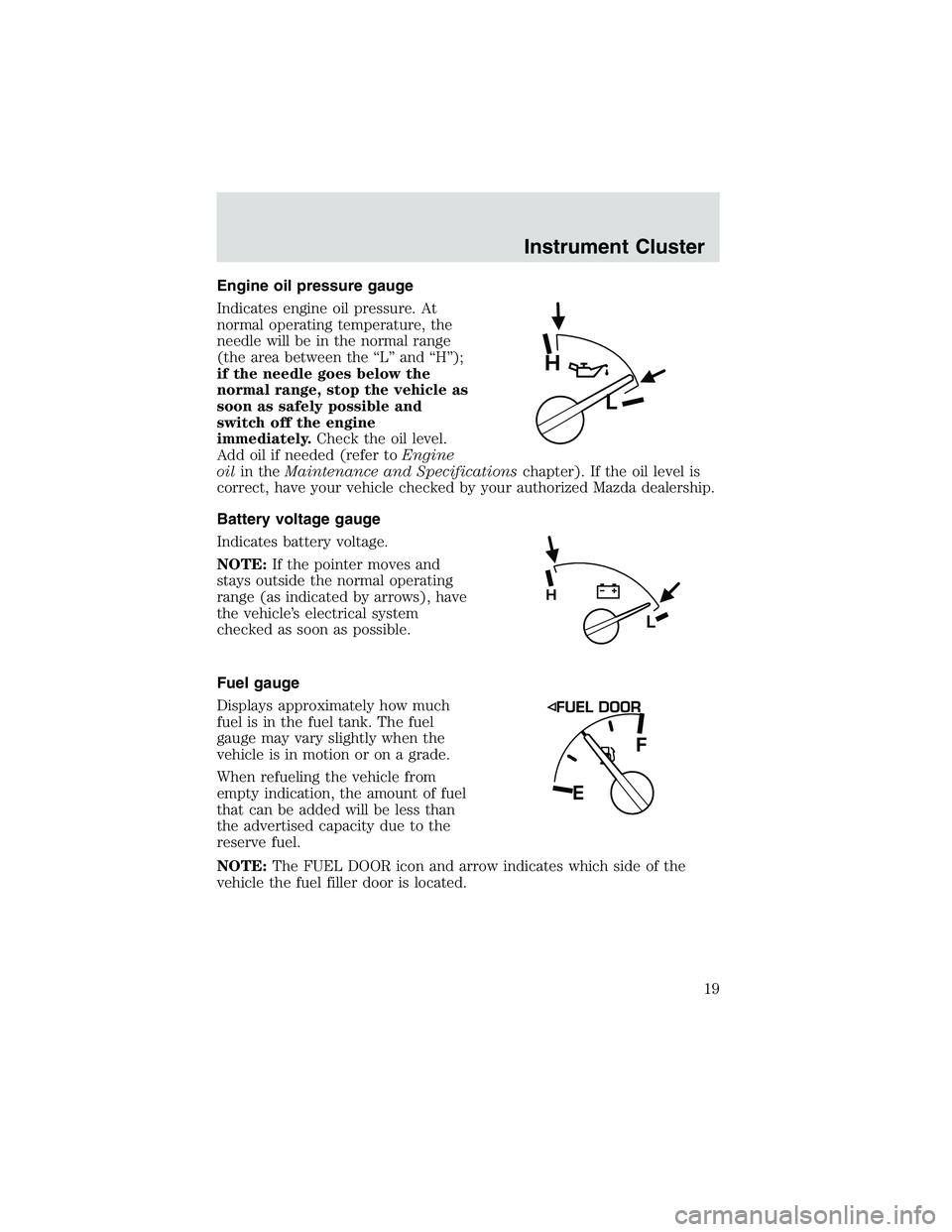
Engine oil pressure gauge
Indicates engine oil pressure. At
normal operating temperature, the
needle will be in the normal range
(the area between the “L” and “H”);
if the needle goes below the
normal range, stop the vehicle as
soon as safely possible and
switch off the engine
immediately.Check the oil level.
Add oil if needed (refer to Engine
oil in the Maintenance and Specifications chapter). If the oil level is
correct, have your vehicle checked by your authorized Mazda dealership.
Battery voltage gauge
Indicates battery voltage.
NOTE: If the pointer moves and
stays outside the normal operating
range (as indicated by arrows), have
the vehicle’s electrical system
checked as soon as possible.
Fuel gauge
Displays approximately how much
fuel is in the fuel tank. The fuel
gauge may vary slightly when the
vehicle is in motion or on a grade.
When refueling the vehicle from
empty indication, the amount of fuel
that can be added will be less than
the advertised capacity due to the
reserve fuel.
NOTE: The FUEL DOOR icon and arrow indicates which side of the
vehicle the fuel filler door is located.
H
L
L
H
Instrument Cluster
19
Page 229 of 288

5. The California Air Resources Board has determined that the failureto perform this maintenance item will not nullify the emission
warranty nor limit recall liability prior to completion of the vehicle’s
useful life.
SCHEDULE II – SPECIAL OPERATING CONDITIONS
If your driving habits FREQUENTLYinclude one or more of the
following conditions:
• Short trips of lessthan 16 km (10 miles) when outside temperatures
remain below freezing.
• Towing a trailer, or carrying maximum loads.
• Operating in severe dust conditions.
• Operating during hot weatherin stop-and-go “rush-hour” traffic.
• Extensive idling, such as police, taxi or door-to-door delivery service.
• High speed operation with a fully loaded vehicle (max. GVW).
• Off-road operation.
Change ENGINE OIL AND OIL FILTER every 3 months or 4,800 km
(3,000 miles) whichever occurs first.
NOTE: Idling the engine for extended periods will accumulate more
hours of use on your vehicle than is actually indicated by the mileage
odometer. Consequently, the odometer reading can be often misleading
when determining the right time to change your engine oil and filter. If
you are using your vehicle in a manner which allows it to remain
stationary while the engine is running for long periods (door-to-door
delivery, taxi, police, power/utility company trucks, or similar duty), then
Mazda recommends you increase the frequency of oil and filter changes
to an interval equivalent to 200 ENGINE HOURS of use. Since most
vehicles are not equipped with hour-meters, it may be necessary for you
to approximate your idle time and plan oil/filter changes accordingly.
Maintenance and Specifications
229
Page 243 of 288
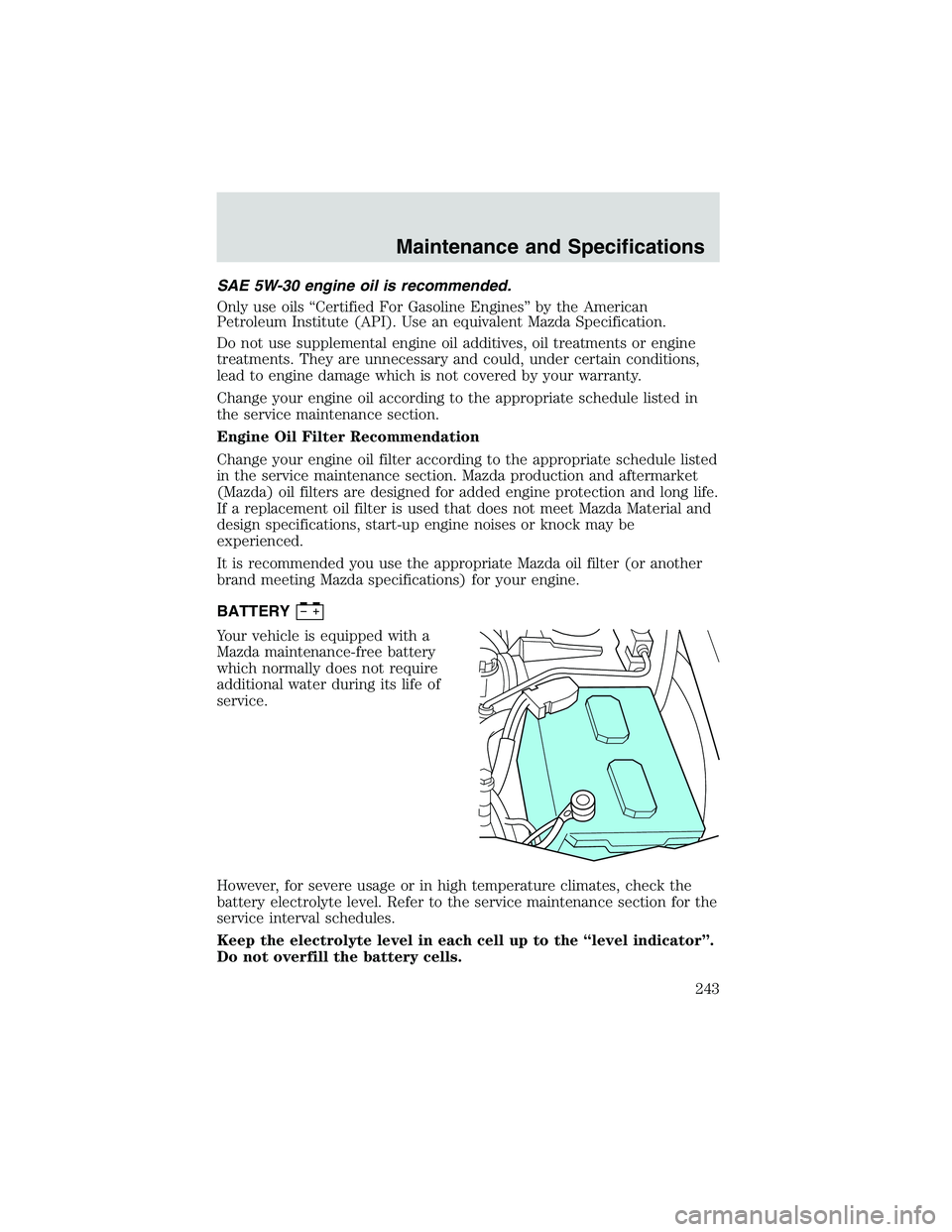
SAE 5W-30 engine oil is recommended.
Only use oils “Certified For Gasoline Engines” by the American
Petroleum Institute (API). Use an equivalent Mazda Specification.
Do not use supplemental engine oil additives, oil treatments or engine
treatments. They are unnecessary and could, under certain conditions,
lead to engine damage which is not covered by your warranty.
Change your engine oil according to the appropriate schedule listed in
the service maintenance section.
Engine Oil Filter Recommendation
Change your engine oil filter according to the appropriate schedule listed
in the service maintenance section. Mazda production and aftermarket
(Mazda) oil filters are designed for added engine protection and long life.
If a replacement oil filter is used that does not meet Mazda Material and
design specifications, start-up engine noises or knock may be
experienced.
It is recommended you use the appropriate Mazda oil filter (or another
brand meeting Mazda specifications) for your engine.
BATTERY
Your vehicle is equipped with a
Mazda maintenance-free battery
which normally does not require
additional water during its life of
service.
However, for severe usage or in high temperature climates, check the
battery electrolyte level. Refer to the service maintenance section for the
service interval schedules.
Keep the electrolyte level in each cell up to the “level indicator”.
Do not overfill the battery cells.
Maintenance and Specifications
243
Page 246 of 288
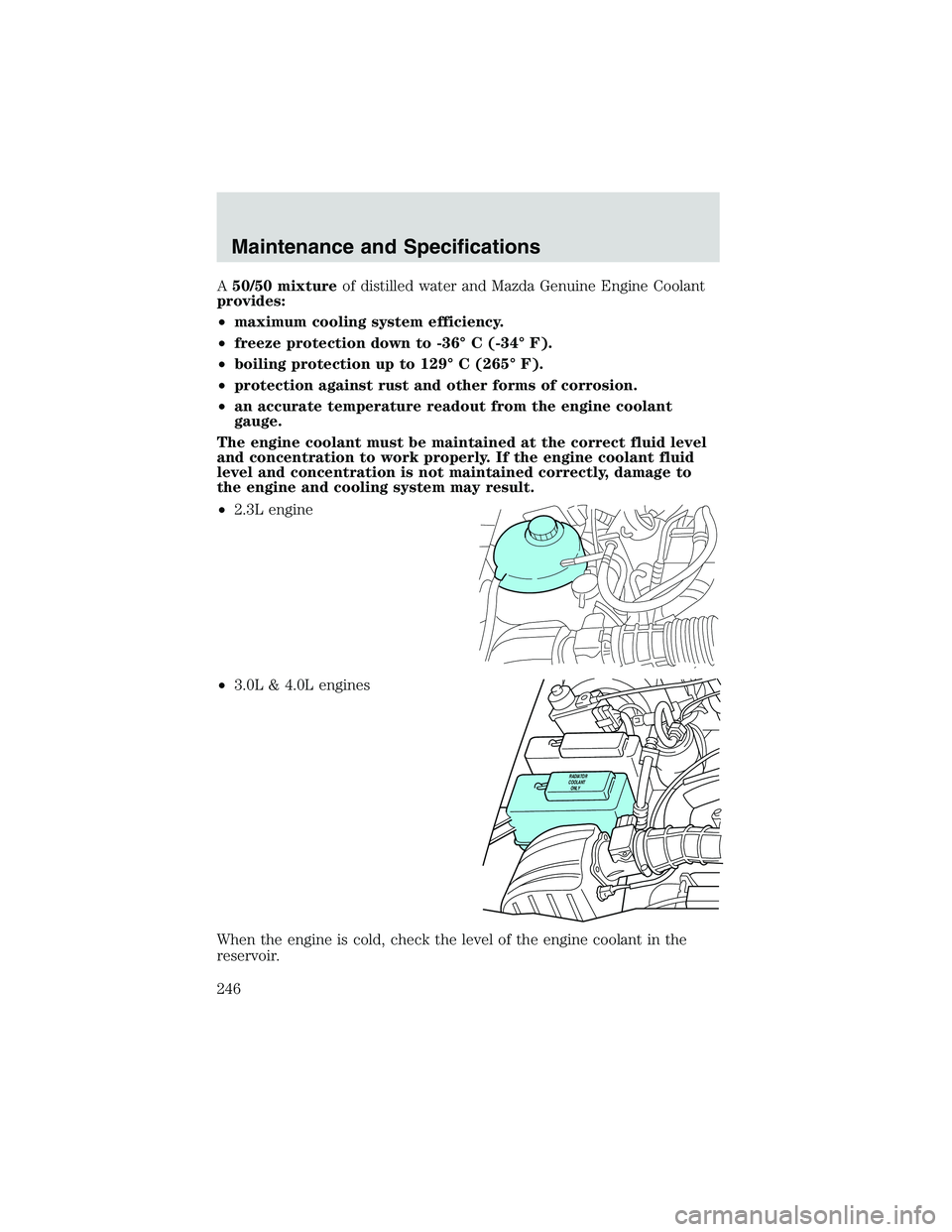
A50/50 mixture of distilled water and Mazda Genuine Engine Coolant
provides:
• maximum cooling system efficiency.
• freeze protection down to -36° C (-34° F).
• boiling protection up to 129° C (265° F).
• protection against rust and other forms of corrosion.
• an accurate temperature readout from the engine coolant
gauge.
The engine coolant must be maintained at the correct fluid level
and concentration to work properly. If the engine coolant fluid
level and concentration is not maintained correctly, damage to
the engine and cooling system may result.
• 2.3L engine
• 3.0L & 4.0L engines
When the engine is cold, check the level of the engine coolant in the
reservoir.
RADIATOR COOLANT ONLY
Maintenance and Specifications
246
Page 258 of 288
![MAZDA MODEL B3000 4WD 2002 Owners Manual •Slow down gradually.
• Driving at reasonable speeds (traveling at 88 km/h [55 mph] uses 15%
less fuel than traveling at 105 km/h [65 mph]).
• Revving the engine before turning it off may reduce MAZDA MODEL B3000 4WD 2002 Owners Manual •Slow down gradually.
• Driving at reasonable speeds (traveling at 88 km/h [55 mph] uses 15%
less fuel than traveling at 105 km/h [65 mph]).
• Revving the engine before turning it off may reduce](/img/28/41052/w960_41052-257.png)
•Slow down gradually.
• Driving at reasonable speeds (traveling at 88 km/h [55 mph] uses 15%
less fuel than traveling at 105 km/h [65 mph]).
• Revving the engine before turning it off may reduce fuel economy.
• Using the air conditioner or defroster may reduce fuel economy.
• You may want to turn off the speed control in hilly terrain if
unnecessary shifting between third and fourth gear occurs.
Unnecessary shifting of this type could result in reduced fuel
economy.
• Warming up a vehicle on cold mornings is not required and may
reduce fuel economy.
• Resting your foot on the brake pedal while driving may reduce fuel
economy.
• Combine errands and minimize stop-and-go driving.
Maintenance
• Keep tires properly inflated and use only recommended size.
• Operating a vehicle with the wheels out of alignment will reduce fuel
economy.
• Use recommended engine oil. Refer to Lubricant specificationsin
this chapter.
• Perform all regularly scheduled maintenance items. Follow the
recommended maintenance schedule and owner maintenance checks
found in your vehicle service maintenance section.
Conditions
• Heavily loading a vehicle or towing a trailer may reduce fuel economy
at any speed.
• Carrying unnecessary weight may reduce fuel economy (approximately
0.4 km/L [1 mpg] is lost for every 180 kg [400 lb] of weight carried).
• Adding certain accessories to your vehicle (for example bug
deflectors, rollbars/light bars, running boards, ski/luggage racks) may
reduce fuel economy.
• Using fuel blended with alcohol may lower fuel economy.
• Fuel economy may decrease with lower temperatures during the first
12–16 km (8–10 miles) of driving.
• Driving on flat terrain offers improved fuel economy as compared to
driving on hilly terrain.
Maintenance and Specifications
258
Page 282 of 288

filter, specifications ................242
recommendations ...................242
refill capacities ........................272
specifications ..................275–276
Exhaust fumes ..........................152
F
Flexible Fuel Vehicle (FFV) ....250
Fluid capacities .........................272
Foglamps .....................................73
Four-Wheel Drive
vehicles ..........................16–17, 165 description ..............................165
driving off road .......................167
electronic shift ........................165
indicator light .........................165
preparing to drive your
vehicle .....................................157
Fuel ............................................250 calculating fuel economy .......256
cap .....................................15, 252
capacity ...................................272
choosing the right fuel ...........253
comparisons with EPA fuel
economy estimates .................259
detergent in fuel .....................255
filling your vehicle with
fuel ...........................250, 252, 256
filter, specifications ................255
fuel pump shut-off switch .....182
gauge .........................................19
improving fuel economy ........256
octane rating ...................254, 276
quality ......................................254
running out of fuel .................255
safety information relating to
automotive fuels .....................250
Fuel - flex fuel vehicle
(FFV) .........................250, 253–254 Fuses ..................................183, 185
G
Gas cap (see Fuel cap) ......15, 252
Gas mileage (see Fuel
economy) ...................................256
Gauges .........................................18
battery voltage gauge ...............19
engine coolant temperature
gauge .........................................18
engine oil pressure gauge ........19
fuel gauge ..................................19
odometer ...................................20
speedometer .............................20
tachometer ................................20
trip odometer ............................20
GAWR (Gross Axle Weight
Rating) .......................................170 calculating ...............................172
definition .................................170
driving with a heavy load ......170
location ....................................170
GVWR (Gross Vehicle Weight
Rating) .......................................170 calculating .......................170, 172
definition .................................170
driving with a heavy load ......170
location ....................................170
H
Hazard flashers .........................182
Headlamps ...................................73 aiming ........................................74
bulb specifications ....................76
daytime running lights .............73
flash to pass ..............................74
high beam ...........................16, 74
replacing bulbs .........................77
turning on and off ....................73
Index
282